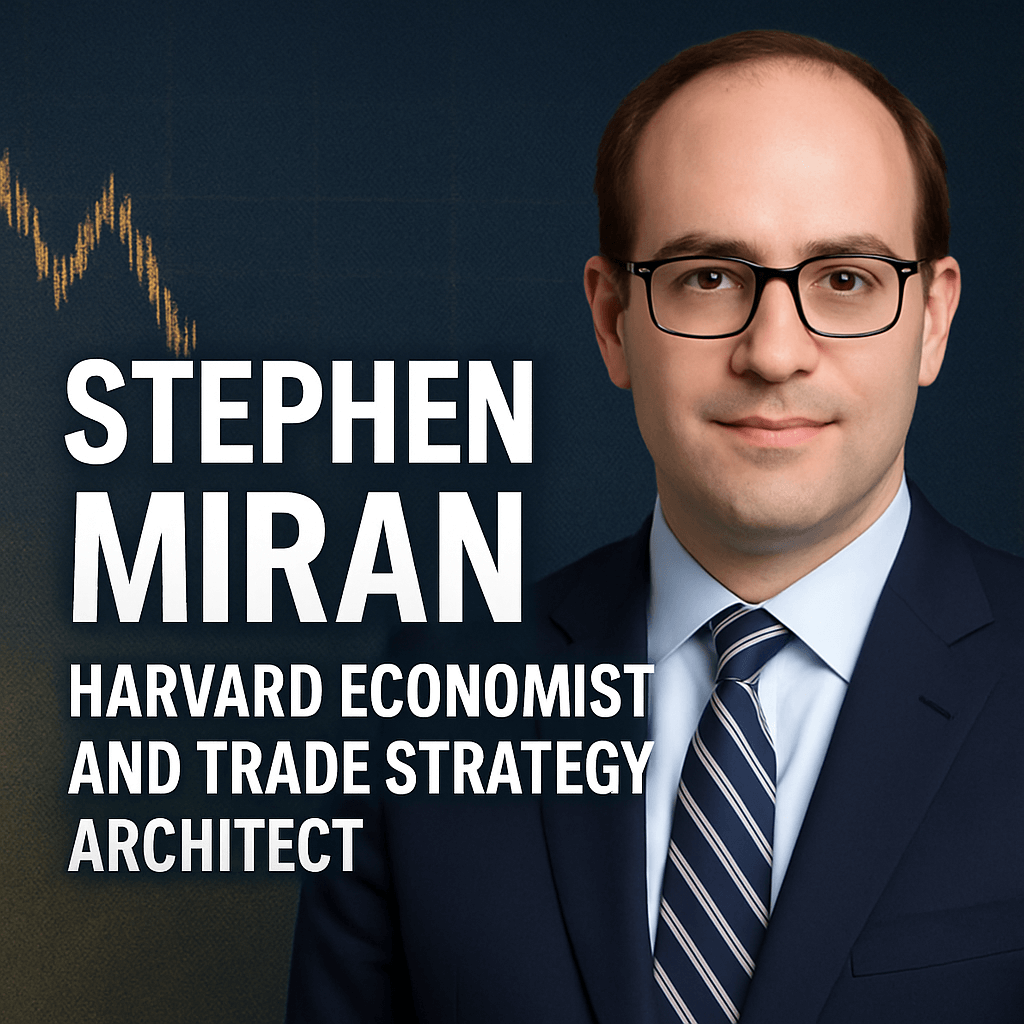Stephen Miran: Harvard Economist and Trade Strategy Architect

Harvard-trained economist Stephen Miran has emerged as the principal architect of the Trump administration’s bold tariff agenda. From an early career revelation about currency manipulation to authoring the so-called “Mar-a-Lago Accord” treatise, Miran has woven technical analysis and policy advocacy into a cohesive framework that reshapes U.S. trade policy.
1. A Front-Row Seat to Currency Manipulation
In 2010, during his first stint as an economist at a currency-focused hedge fund, Miran witnessed government-managed FX regimes operate far outside textbook norms. He observed:
“China’s central bank was accumulating dollar reserves at a pace that kept the renminbi artificially undervalued by 15–20% against the dollar, boosting exports and depressing U.S. manufacturing output.”
Technically, this involved sustained interventions in the onshore and offshore renminbi markets, sterilized by issuing local bonds to mop up liquidity. Miran calculated that China’s balance-sheet operations lowered its real effective exchange rate (REER) and created a persistent U.S. trade deficit of over $300 billion annually.
2. From Hedge Funds to the White House
After earning his PhD in economics under Martin Feldstein at Harvard—where he specialized in state borrowing rules, employment elasticities, and fiscal-monetary interactions—Miran led macro strategy at several top investment firms. In April 2020, he joined the U.S. Department of the Treasury as a senior advisor, helping model and implement $2 trillion in emergency fiscal measures during the downturn. Relying on dynamic stochastic general equilibrium (DSGE) models, he assessed multipliers for direct relief versus business loans.
By late 2023, Miran’s series of op-eds for the Manhattan Institute and the Wall Street Journal caught the attention of senior Republican policymakers. His 41-page “Mar-a-Lago Accord” and subsequent essays became the blueprint for Trump’s second-term trade platform.
3. The Mar-a-Lago Accord: Rewriting the Rules of Global Trade
Drawing inspiration from the 1985 Plaza Accord, Miran proposed a multinational currency agreement where major reserve-holding nations would agree to:
- Gradually deplete excess dollar reserves by 20–30% over five years;
- Redirect maturities into century-long U.S. treasuries to avoid yield shocks;
- Coordinate FX interventions to smooth volatility in major pairs (USD/EUR, USD/JPY, USD/CNY).
This plan aimed to lower the dollar’s real exchange rate, boost U.S. exports by 10–15%, and reduce the trade deficit while preserving the dollar’s reserve status.
4. Designing Tariff Architecture
Miran champions a gradual tariff ramp using Sections 232 and 301 of the Trade Expansion Act. Key features include:
- A schedule of incremental 2–4% tariff increases per quarter;
- Pre-announced threshold triggers tied to domestic capacity utilization rates (e.g., 80% steel mill utilization);
- Transparency through published tariff-rate quotas (TRQs) and guidance on non-tariff barrier reductions.
Economists model pass-through elasticities using GTAP simulations, estimating that full absorption by foreign exporters occurs within 12–18 months, leaving U.S. consumers shielded from direct price hikes.
5. Legal and Institutional Constraints on Tariff Authority
On May 28, 2024, the U.S. Court of International Trade enjoined the administration’s plan for reciprocal “global” tariffs, ruling that only Congress can impose across-the-board duties. The court upheld specific 232 duties on steel, aluminum, automotive and defense‐related imports.
Trade law experts note that continued reliance on Section 232 (national security) must be defensible under World Trade Organization (WTO) Article XX, and that appeals will shape the contours of executive tariff power. According to trade attorney Jane Aronson, “The administration may need new authorizations or risk WTO dispute settlement against broad, nondiscriminatory tariffs.”
6. Technical Analysis of Tariff Impact Models
Leading research centers such as the Peterson Institute and NBER have deployed dynamic computable general equilibrium (CGE) models to simulate the macro impact of Miran’s tariffs. Key findings:
- Short-run GDP drag of 0.3–0.5 percentage points due to re-pricing effects;
- Inflation shock of up to 50 basis points, gradually offset by increased domestic output;
- Long-run gain in manufacturing value-added of 0.8–1.2% as onshoring investments materialize.
Econometric studies estimate a pass-through elasticity of 0.7 for capital goods and 0.5 for consumer goods, implying partial absorption by foreign firms.
7. Geopolitical and Supply Chain Implications
Miran’s framework dovetails with broader supply chain resilience efforts. By incentivizing onshoring of semiconductors and critical minerals, the U.S. aims to mitigate strategic dependence on China. AI-driven trade analytics now track real-time changes in import flows, alerting policymakers when non-tariff barriers rise above a 5% threshold.
According to a CSIS white paper, diversifying supply chains to ASEAN and Latin America could reduce China’s share of U.S. imports from 20% to 12% over five years, aligning with Miran’s “burden sharing” via bilateral tariff negotiations.
8. Mainstream Critiques and Economic Outlook
- Larry Summers: Labels the Mar-a-Lago proposals “a conceit” unlikely to gain multilateral buy-in.
- Fitch Ratings: Projects 2025 GDP growth slipping to 1.7% and core inflation rising toward 3% if tariffs remain elevated.
- IMF: Recommends caution, noting large-scale protectionism can trigger retaliatory cycles and hamper global growth.
University of Michigan survey data suggests consumer inflation expectations have ticked up 15 basis points since December 2023, reflecting unease over potential price pass-through.
9. Conclusion: A New Chapter in U.S. Trade Policy
Stephen Miran’s unique blend of academic rigor, technical modeling, and policy advocacy has propelled him from relative obscurity to the helm of U.S. trade strategy. By melding currency-accord concepts with a calibrated tariff architecture, he envisions a profound realignment of global commerce—one that reframes America’s role from passive importer to strategic negotiator. Whether this contrarian path yields the promised gains or stokes broader inflationary pressures will define the next era of U.S. economic policy.